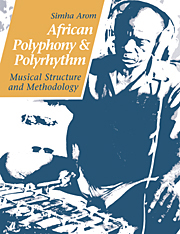Book contents
- Frontmatter
- Contents
- List of illustrations
- Foreword by György Ligeti
- Preface
- Acknowledgements
- BOOK I THE MUSIC OF THE CENTRAL AFRICAN REPUBLIC
- BOOK II AFRICAN POLYPHONIC MUSIC
- BOOK III TECHNICAL TOOLS: METHODS OF RECORDING POLYPHONIC MUSIC FOR TRANSCRIPTION
- 1 The need for transcription
- 2 The difficulties of transcription
- 3 Earlier methods
- 4 Towards a new method
- 5 Theoretical assumptions
- 6 Technical equipment: description and use
- 7 From recording to transcription
- 8 Checking the results
- 9 Potentialities
- 10 Anthropological validity
- BOOK IV THEORETICAL TOOLS
- BOOK V THE ORGANISATION OF TIME IN AFRICAN MUSIC
- BOOK VI STRUCTURAL PRINCIPLES AND THEIR APPLICATION
- Conclusion
- Bibliography
5 - Theoretical assumptions
Published online by Cambridge University Press: 27 January 2010
- Frontmatter
- Contents
- List of illustrations
- Foreword by György Ligeti
- Preface
- Acknowledgements
- BOOK I THE MUSIC OF THE CENTRAL AFRICAN REPUBLIC
- BOOK II AFRICAN POLYPHONIC MUSIC
- BOOK III TECHNICAL TOOLS: METHODS OF RECORDING POLYPHONIC MUSIC FOR TRANSCRIPTION
- 1 The need for transcription
- 2 The difficulties of transcription
- 3 Earlier methods
- 4 Towards a new method
- 5 Theoretical assumptions
- 6 Technical equipment: description and use
- 7 From recording to transcription
- 8 Checking the results
- 9 Potentialities
- 10 Anthropological validity
- BOOK IV THEORETICAL TOOLS
- BOOK V THE ORGANISATION OF TIME IN AFRICAN MUSIC
- BOOK VI STRUCTURAL PRINCIPLES AND THEIR APPLICATION
- Conclusion
- Bibliography
Summary
At this point, we must set out the theoretical foundations of our method. We will first have to state a postulate. Any polyphonic piece of music can be looked at as a complex sound structure characterised by the superposition of a given number of coherently related monodies. This leads us to the following assumption: insofar as a polyphonic piece is based on a coherent structuring of all its parts, each of these parts must be coherent in itself. If this is true, each part should be playable separately, i.e., have its own individual existence in sound, just as it exists in the mind of the person who performs it. By this hypothesis, if we can isolate each part and determine the points at which it fits together with the others (or at least one other), we may assume that we have all the elements we need to reconstitute the polyphonic structure. For insofar as the relationships between parts, or between any part and the whole, are coherent, the number of linkage points must be relatively small. The whole can thus be reconstructed, even without the complete set. These interrelations are furthermore based on the principle that all the musicians performing a polyphonic piece will start to play or sing their parts, not simultaneously, but consecutively. This principle holds not only for traditional African music, but also for almost all known forms of orally transmitted polyphony. The only reference used by the individual musician will thus be the part of the musician (or one of the musicians) who has already come in.
The order of entry varies from one repertory to another. It may be fixed by tradition or remain undetermined. This should be ascertained during a preliminary investigation.
- Type
- Chapter
- Information
- African Polyphony and PolyrhythmMusical Structure and Methodology, pp. 105 - 106Publisher: Cambridge University PressPrint publication year: 1991

